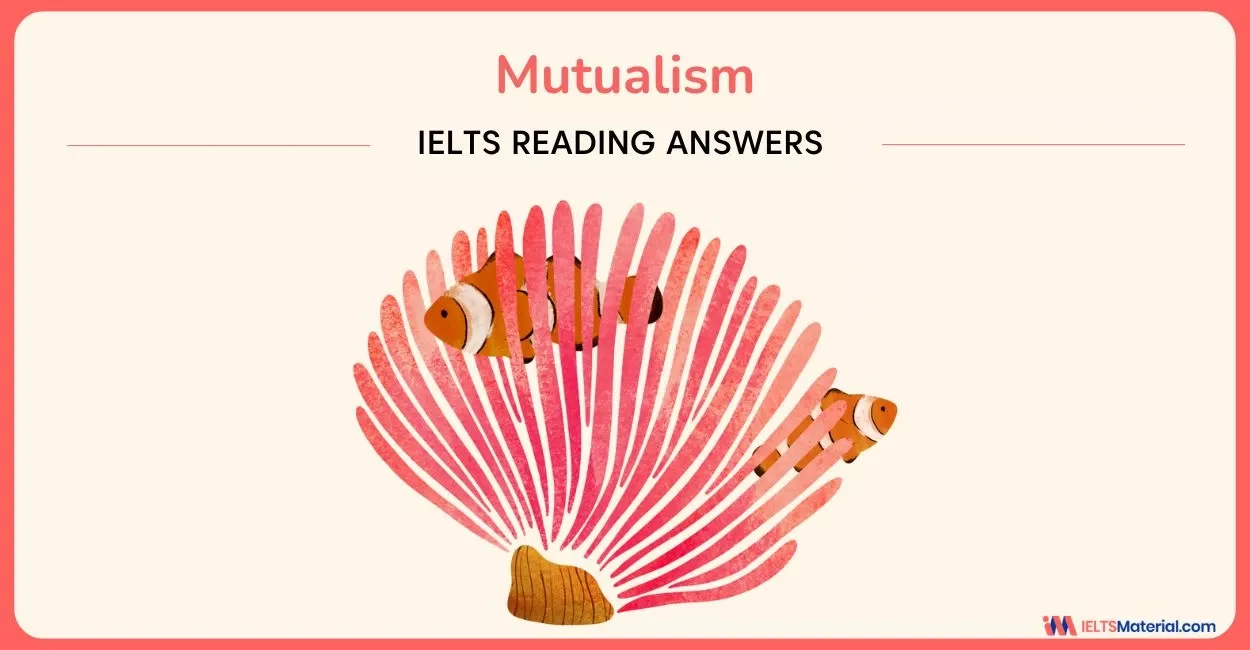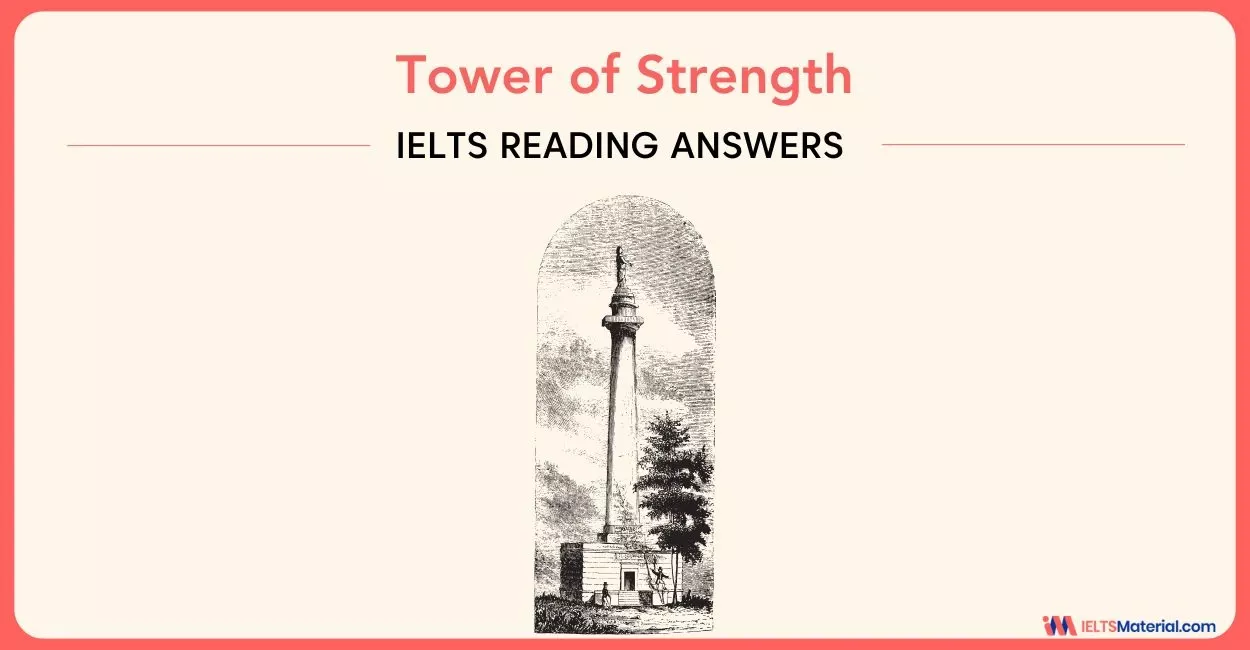Tower of Strength - IELTS Reading Answers
13 min read
Updated On
-
Copy link
Prepare for the IELTS exam with Tower of Strength Reading Answers to improve your reading score. Find out how to handle different types of IELTS Reading questions, along with answers and explanations, & be prepared to achieve your desired Band 9 score.
Table of Contents

Limited-Time Offer : Access a FREE 10-Day IELTS Study Plan!
Jumping straight into a passage without a game plan can waste precious minutes. Effective IELTS readers preview the text and make predictions before diving into the questions. However, to master this skill you have to begin targeted practice of reading samples from the best IELTS Reading books, like ‘Tower of Strength Reading Answers’.
As a result, to improve your performance in the reading module, this blog provides you with the passage and questions for ‘Tower of Strength IELTS Reading Answers’ and allows you to check your answers against the provided answer key with explanations and IELTS exam preparation tips for band score of 8+.
Passage for Tower of Strength Reading Answers
The ‘Tower of Strength’ Reading Answers passage provided below offers valuable practice for the IELTS reading exam. Practicing this passage and focusing on similar IELTS Reading topics for General and Academic will greatly improve your skills in tackling various reading passages.
You should spend about 20 minutes on Questions 1-14, which are based on the reading passage below.
Tower of Strength
A Of all the stories of art influencing science, tensegrity is one of the most far-reaching. On one level, tensegrity is a system of creating architecture or sculptures involving rods in compression and wires in tension. It was invented by sculptor Kenneth Snelson at Black Mountain College, the hotbed of international modernism, in 1948. At the time, Snelson was taking part in a summer school with the engineer Buckminster Fuller, who pioneered the idea of applying geometric forms to architectural and engineering innovation.
B Using an abstract sculpture as a starting point, Snelson then added tension wires to the free-floating members. Fuller encouraged him and when they met up again in 1949, Snelson had perfected a concept in which stiff rods can be supported without touching a network of wires. Although “tensegrity’ (from ‘tensional integrity`) was coined by Fuller, the idea was entirely Snelson’s, and he went on to make many more tensegrity sculptures, the most famous of which is the sixty-foot-high Needle Tower (1968), now at the Hirshhorn Museum and Sculpture Garden, Washington DC.
C Basic tensegrity structures can be made from three drinking straws, six paper clips, and nine rubber bands. When the structure is wired up, you can see that none of the rods actually touch; they’re held in equilibrium by the rubber bands. Even this simplest model has very interesting properties. Although drinking straws are weak, with a tendency to buckle, the tension bands hold them in such a way that the compressive force is always directed straight down the tube and buckling doesn’t happen. The first thing you notice if you make one is that it is immensely fiddly to assemble — pieces keep falling apart — but once the last band is secured, you can fling the object around, squash it, and it seems indestructible. The structure isn’t symmetrical in its properties. In one direction, it squashes flat and bounces back. In the other direction, it resists the pressure. If you wanted to create versatile 3D structures out of nothing much, tensegrity would take some beating.
D It is strange that architects and engineers didn’t discover the principle before 1948 since the benefits of structures held in tension over traditional building techniques had been known since the invention of the suspension bridge in 1796. And the great maverick biologist D’Arcy Thompson in On Growth and Form (1917) had extensively analysed the principles of tension and compression both in nature and engineering. Kenneth Snelson believed that tensegrity was a pure art and that it would never be really useful architecturally. It took some time to prove him wrong, but in the 1980s, tensegrity architecture began to appear. The key protagonist was David Geiger and the first important structure was his Gymnastics Hall at the Korean Olympics in 1988.
E Five years later, its significance in quite a different field became apparent when scientists described the tensegrity model of cell structure, and this is where the principle is now making waves. What is it that prevents living things from collapsing to a blob of jelly on the floor? Unsurprisingly, it is likely to be tensegrity. For a long time, biologists ignored the mechanical properties of cells: they were just `elastic bags` full of interesting chemicals. But there has to be an architecture; tissue is tough, resilient stuff that keeps its shape.
F The human body is certainly a tensegrity structure; it consists of 206 bones — tensegrity rods — that do not touch, held together by tendons and muscles. And the tension of living cells seems to be maintained by tensegrity structures within the cell; microfilaments play the role of the rubber bands and stiff microtubules are the rods. Donald Ingber, at the Harvard Medical School, researchers how cells move and stick to each other, and he believes that tensegrity offers ‘the most unified model of cell mechanics’. It explains some basic properties of cells very well.
G If cells are placed on a microscope slide, they flatten under gravity. When cells are surrounded by other cells, proteins called integrins attach one cell to another at specific locations. These act as tensegrity wires, pulling the cells taut in all directions. When the integrin network is disrupted, the cells sag. Whether or not the cell is a tensegrity structure is still controversial, but in a series of recent papers, Ingber and his team have been gradually picking off the objections with detailed studies of cell structure. For the lay observer, pictures of a cell showing triangular structures resembling a geodesic dome are highly suggestive of tensegrity.
H It has been a long road since Black Mountain College in 1948, but it all comes back to Kenneth Snelson and his sculpture. Once asked what he would save from a fire in his office, Donald Ingber replied: ‘The tensegrity model made by Kenneth Snelson, a gift from the artist himself’.
Questions for Tower of Strength Reading Answers
The ‘Tower of Strength’ is an IELTS Academic Reading passage with 14 questions. The question types in this reading passage include:
- IELTS Reading Matching Features (Q. 1-3)
- IELTS Reading Matching Information (Q. 4-10)
- IELTS Reading Short Answer Questions (Q. 11-14)
Questions 1-3
According to the information in the Reading Passage, when were the following made?
Write the correct letter A, B, C, or D next to questions 1-3.
1 An advance in biology based on tensegrity principle
2 A work of art based on tensegrity principle
3 A building based on tensegrity principle
A the 18th century
B the first half of the 20th century
C the second half of the 20th century
D the 21st century
Questions 4 -10
The Reading Passage has eight paragraphs, A-H.
Which paragraph contains the Following information?
NB: You may use any letter more than once.
4 An error made by the inventor of tensegrity
5 The branch of science on which tensegrity is currently having the greatest impact
6 The writer’s surprise that tensegrity remained unknown in engineering
7 An account of how a sculpture was made
8 An unresolved issue concerning the nature of individual cell structure
9 An explanation of why a basic tensegrity structure keeps its shape
10 An analogy between components of a tensegrity model and a skeleton
Questions 11-14
Answer the questions with words from the Reading Passage.
Write NO MORE THAN THREE WORDS for each answer.
11 Who first used the word ‘tensegrity’?
12 Which parts of the tensegrity model prevent the straws losing their shape?
13 Which parts of a cell hold its microtubules in place?
14 What substances join cells to each other?
Answers for Tower of Strength with Location and Explanations
Now it is time to cross-check your answers using the answer key below for the Tower of Strength IELTS Reading passage. Make sure to create strategies based on the feedback from this practice and master IELTS Reading question types with examples.
1 Answer: C
Question type: Matching Features
Answer location: Paragraph E, lines 1-2
Answer explanation: In the concluding line of Paragraph D, the year 1988 is mentioned. In the beginning of the next paragraph, it is stated that five years later, its significance in quite a different field became apparent when scientists described the tensegrity model of cell structure… . This points out that in 1993, or in the second half of the 20th century, the advancement in Biology (cell structure) was seen due to the significant tensegrity principles. Hence, the answer is C.
2 Answer: B
Question type: Matching Features
Answer location: Paragraph B, lines 6 – 7
Answer explanation: It is stated that although “tensegrity’ (from ‘tensional integrity`) was coined by Fuller, the idea was entirely Snelson’s, and he went on to make many more tensegrity sculptures, the most famous of which is the sixty-foot-high Needle Tower (1968), now at the Hirshhorn Museum and Sculpture Garden, Washington DC. So, it is clear that Snelson created many sculptures, including the famous Needle Tower using the tensegrity principle since he first invented the concept in 1948, which is the first half of the 20th century.Hence, the answer is B.
3 Answer: C
Question type: Matching Features
Answer location: Paragraph D, line 9
Answer explanation: In Paragraph D, it is clearly mentioned that in the 1980s, tensegrity architecture began to appear. The key protagonist was David Geiger and the first important structure was his Gymnastics Hall at the Korean Olympics in 1988. As 1988 signifies the second part of the 20th century, the answer is C.
Unlock Explanations
4 Answer: D
Question type: Matching information
Answer location: Paragraph D, line 6
Answer explanation: In paragraph D, it is given that Kenneth Snelson, the inventor of tensegrity, believed that tensegrity was a pure art and that it would never be really useful architecturally. It took some time to prove him wrong…. Therefore, it is clear that Snelson made an error about tensegrity and eventually was proven wrong in this paragraph. Hence, the answer is D.
5 Answer: E
Question type: Matching information
Answer location: Paragraph E, lines 1-3
Answer explanation: In paragraph E, It is mentioned that its significance in quite a different field became apparent when scientists described the tensegrity model of cell structure, and this is where the principle is now making waves. So, it is biology, a branch of science, where the tensegrity principle is currently having the greatest impact (making waves). Hence, the answer is E.
6 Answer: D
Question type: Matching information
Answer location: Paragraph D, line 1
Answer explanation: In the introducing line of Paragraph D, the writer states that it is strange that architects and engineers didn’t discover the principle before 1948 since the benefits of structures held in tension over traditional building techniques had been known since the invention of the suspension bridge in 1796. The use of the word ‘strange’ shows the writer’s surprise at how tensegrity remained unknown to engineers and architects and hence, the answer is D.
7 Answer: C
Question type: Matching information
Answer location: Paragraph C, lines 1-12
Answer explanation: Paragraph C begins with the explanation that basic tensegrity structures can be made from three drinking straws, six paper clips, and nine rubber bands. When the structure is wired up, you can see that none of the rods actually touch; they’re held in equilibrium by the rubber bands. Moreover, it continues to offer a description of a structure created using tensegrity. Hence, the answer is C.
8 Answer: G
Question type: Matching information
Answer location: Paragraph G, line 5
Answer explanation: It is mentioned that whether or not the cell is a tensegrity structure is still controversial. It is quite clear that paragraph G states that there is an unresolved issue concerning the nature of individual cell structure although research is being carried out regarding the objections. Hence, the answer is G.
9 Answer: C
Question type: Matching information
Answer location: Paragraph C, lines 4-
Answer explanation: This explains that although drinking straws are weak, with a tendency to buckle, the tension bands hold them in such a way that the compressive force is always directed straight down the tube and buckling doesn’t happen. Moreover, the structure is able to retain its properties because it is asymmetrical. Hence, the answer is C.
10 Answer: F
Question type: Matching paragraph information
Answer location: Paragraph F, lines 1-4
Answer explanation: It is mentioned that the human body is certainly a tensegrity structure; it consists of 206 bones — tensegrity rods — that do not touch, held together by tendons and muscles. Therefore, the skeleton of the human body, comprising 206 bones, is comparable to a tensegrity structure. Hence, the answer is F.
11 Answer: Buckminster Fuller
Question type: Short answer type
Answer location: Paragraph B, lines 4-5
Answer explanation: It is given in the passage that “tensegrity’ (from ‘tensional integrity`) was coined by Fuller. As Fuller is credited with first using the term, the answer is Buckminster Fuller.
12 Answer: Tension bands
Question type: Short answer type
Answer location: Paragraph C, lines 2-3
Answer explanation: It is stated that when the structure is wired up, you can see that none of the rods actually touch; they’re held in equilibrium by the rubber bands. So, the tension bands in a tensegrity model help keep its structure. Hence the answer is tension bands.
13 Answer: Microfilaments
Question type: Short answer type
Answer location: Paragraph F, line 4
Answer explanation: It is mentioned that the tension of living cells seems to be maintained by tensegrity structures within the cell; microfilaments play the role of the rubber bands and stiff microtubules are the rods. In paragraph C it is stated that the rubber bands maintain the shape of the structure, so, it is proved that microfilaments act like rubber bands and hold microtubules in place. Hence, microfilaments is the answer.
14 Answer: Integrins
Question type: Short answer type
Answer location: Paragraph G, line 2
Answer explanation: It is clearly given that proteins called integrins attach one cell to another at specific locations. Hence, Integrins is the answer.
Learn quick methods to conquer passages like ‘Tower of Strength’ within 20 minutes.
Join our FREE IELTS webinars!
Tips to Solve the Passage Question Types in the Tower of Strength Reading Answers
Let us check out some quick IELTS Reading tips and techniques to increase your reading speed and overall comprehension to answer the passage question types in the Reading Answers of Tower of Strength.
Matching Features
- Identify keywords (NOT years): Do not look for years directly (e.g., 1948, 1988). Instead, underline keywords like ‘advance in biology’, ‘work of art’, ‘building’. You will then scan for contextual clues around those terms that indicate time.
- Locate time references: When you find those keywords, circle the nearest date or period mentioned (e.g., 1988 → late 20th century = option C). IELTS passages often hide this clue in the same or next sentence.
- Use logic between sentences: Sometimes the event’s year is not directly linked in the same line. For example, ‘five years later’ after a mentioned date (1988 → 1993). Be ready to infer using basic arithmetic or logical connections.
- Cross-check period labels: Always mentally map the century to its correct years.
- 18th century → 1700s
- First half of 20th → 1900–1950
- Second half of 20th → 1951–2000
- 21st → 2001–present
- Avoid traps: Some paragraphs may mention multiple time periods. They are the IELTS Reading distractors. So, focus only on the one linked to the described development (biology, art, or architecture). Don’t mix them up.
Matching Information
- Underline keywords in each statement: Let us go through some examples to understand. The examples are as follows:
- ‘error made by the inventor’→ look for words like mistake, wrong, proved incorrect
- ‘riter’s surprise’→ look for tone markers like strangely, oddly enough, surprisingly.
- Be aware of and use synonyms: IELTS paraphrases heavily. So, it is recommended to always think of paraphrased versions of your keywords while scanning. For example: ‘greatest impact’ = ‘making waves’; ‘unresolved issue’ = ‘still controversial’.
- Scan; do not read the paragraphs entirely: Start by reading the first and last sentence of each paragraph. The IELTS passages often place main ideas there.
- Mark the paragraph letters in the margin: While skimming, jot down 1–2 keywords per paragraph. This helps you locate information faster when matching.
- Use elimination: If two statements feel similar (e.g., 7 and 9 both mention ‘structure’), note that IELTS often splits description and function into separate paragraphs. Pay attention to verb focus – ‘was made’ (7) vs ‘keeps its shape’ (9).
- Revisit paragraphs for confirmation: Do not rely on your first impression. If you have a doubt, quickly scan again for a confirming phrase before finalizing.
IELTS Reading Short Answer Questions
- Focus on WHO/WHAT/WHICH in each question:
- Q11 → Who first used the word…? → look for a person’s name.
- Q12 → Which parts…? → look for plural objects/components.
- Q13 & Q14 → look for scientific terms linked with cells.
- Scan for unique terms: Names (e.g., Fuller), technical words (microfilaments, integrins), and capitalized or italicized words usually signal the answer area.
- Write exact words from the passage: For this type of question, do not change word forms or add articles. For example: write ‘Buckminster Fuller’, not ‘the Fuller’.
- Check word count strictly: “NO MORE THAN THREE WORDS” means “a, an, the” count too. For example: ‘tension bands’, which is 2 words, is correct. However, if you write ‘the tension bands’, it is incorrect as it counts as 3 words. So, avoid extra and unnecessary words and stick to the given word count in the instructions.
- Avoid synonyms in answers: Unlike matching or IELTS Reading Multiple Choice Questions, short answer questions require exact wording from the passage. So, do not paraphrase.
Well done on completing the Tower of Strength reading passage! You must improve your reading speed, familiarity with questions, and ability to retrieve information in order to achieve a high IELTS score. So, to crack IELTS Reading in the first go, try solving more of the recent IELTS Reading practice tests and work on your comprehension skills.
Useful Links:
- Bricks The Versatile Building Material - IELTS Reading Answer
- Calisthenics – IELTS Reading Answers
- Power from The Earth - IELTS Reading Answers
- The Stress of Relocation - IELTS Reading Answers
- Coming of Age – IELTS Reading Answers
- How to Complete IELTS Reading in Less than an Hour?
- Useful IELTS Reading Articles, Website Resources and Material for Academic and General Training
Practice IELTS Reading based on question types

Start Preparing for IELTS: Get Your 10-Day Study Plan Today!
Explore other Reading Actual Tests

Kasturika Samanta

Nehasri Ravishenbagam

Kasturika Samanta

Kasturika Samanta
Recent Articles

Nehasri Ravishenbagam

Haniya Yashfeen

Haniya Yashfeen

Haniya Yashfeen




Post your Comments